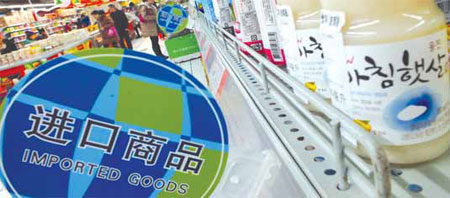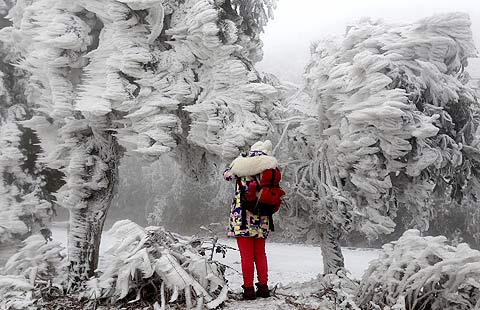Robust trade eases slowdown worries
Updated: 2014-02-13 08:27
By Li Jiabao (China Daily USA)
|
||||||||
China's trade growth exceeded market expectations last month, taking the edge off worries about a slowdown in the world's second-largest economy.
Analysts contend that exports will continue to improve this year. That trend will support moderate economic expansion while leaving room for the leadership to restructure the growth model away from a heavy reliance on investment and exports to one based on domestic demand.
Last month, exports rose 10.6 percent to $207.13 billion, much faster than the 4.3 percent rise in December, the General Administration of Customs said on Wednesday.
Imports increased 10 percent to $175.27 billion, the fastest pace in six months.
Total trade was up 10.3 percent year-on-year to $382.4 billion.
The trade surplus widened to $31.86 billion from $25.64 billion in December.
"January export growth was much stronger than market expectations, especially given inflated trade flows through over-invoicing involving high technology goods and gold transactions earlier last year (and) the weak Purchasing Managers' Index," Hu Yifan and Zhang Yuan, analysts with Haitong International Research Ltd in Hong Kong, wrote in a research note.
"The only explanation can be the positive impact of a gradual recovery of the global economy."
China's total trade with the European Union, the country's largest trade partner, surged 14.6 percent in January to $341.19 billion, with exports to the bloc up 18.8 percent, compared with growth of 3.9 percent in December.
Trade with the United States rose 8.8 percent to $299.23 billion, with China's exports growing 10.7 percent, compared with 1.9 percent in December.
Total trade with Japan expanded 7.8 percent to $170.05 billion, despite strained ties.
Trade with Hong Kong declined 20.6 percent to $166.73 billion.
Analysts had expected a weak trade performance last month, given the base effect. In January 2013, widespread over-invoicing of exports took place to disguise capital inflows.
The weeklong Lunar New Year holiday, which began on Jan 31 this year - about two weeks earlier than in 2013 - was also expected to depress the January figures. Most manufacturing workers are migrant laborers who leave for their rural homes well ahead of the holiday each year, cutting the number of working days.
"There is little evidence that over-invoicing artificially increased export growth data significantly in January. Instead, growth of exports to developed countries - not likely to be associated with over-invoicing - rose substantially in January.
"Thus, while we remain puzzled by the strength of the export data, they seem to point to actual strength," said a report by Louis Kuijs and Tiffany Qiu, Royal Bank of Scotland Plc economists in Hong Kong.
Yang Weixiao, a senior analyst at Lianxun Securities Co Ltd in Beijing, called the January trade figures "rosy but trustworthy", because the mainland's exports to Hong Kong, a prime spot for fake transactions in the past, fell 18 percent in January, compared with a 2.3 percent rise in December.
"Trade growth in February may slightly slow down, but the outlook is optimistic, and trade will gradually improve in the second and third quarters this year.
"A steady improvement of exports will play a very important role this year in stabilizing economic growth and easing the risk of job losses, giving the leadership valuable opportunities to improve the economic structure," Yang said.
Concerns over a slowdown in China rose as activity in the manufacturing and services sectors eased in January.
The manufacturing Purchasing Managers' Index dropped to a six-month low of 50.5 in January, from 51 in December. The PMI for services, released by HSBC Holdings Plc, eased to 50.7 in January from 50.9 in December. A reading above 50 for either index indicates expansion.
"The surprising import acceleration in January defies concerns (over a slowdown) as China imported record volumes of iron ore, crude oil and copper. This suggests robust domestic demand and improving development of the manufacturing industries," said Liu Xuezhi, a researcher at the Bank of Communications Ltd in Shanghai.
The RBS report said trade data will remain choppy and hard to interpret in the coming months, "but we expect export momentum to continue to develop favorably in 2014, on the back of improving global demand growth".
Analysts at Haitong International Research said tapering of quantitative easing, combined with a weak recovery of global demand, difficulties in emerging countries and tight liquidity in China prompted them to "retain our view of a moderate growth in trade in 2014".
Haitong International Research has forecast 7 percent growth for exports and 9.1 percent for imports.
Commerce Ministry figures show that China's trade in services rose 14.7 percent in 2013 to $539.64 billion, accounting for 11.5 percent of overall trade.
Dai Tian contributed to this story.
lijiabao@chinadaily.com.cn
|
Customers weigh up imported goods at a supermarket in Yichang, Hubei province. China's imports increased 10 percent to $175.27 billion in January, the fastest pace in six months, the General Administration of Customs said on Wednesday. Liu Junfeng / for China Daily |
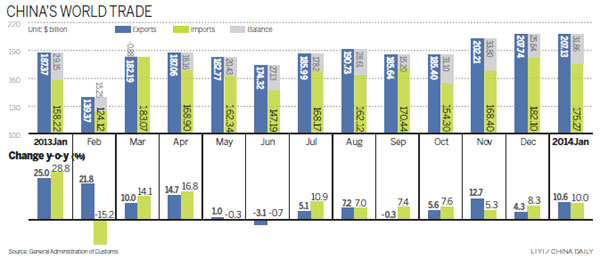
(China Daily USA 02/13/2014 page13)

 Deadly ice and snow storm slams US South
Deadly ice and snow storm slams US South
 Starlings to spend the winter in Israel
Starlings to spend the winter in Israel
 Highlights of Singapore Airshow
Highlights of Singapore Airshow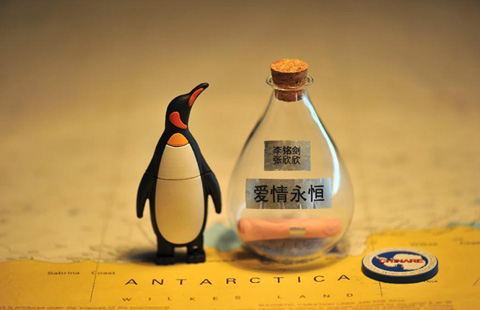
 Sailors of Xuelong release 'love drift bottles'
Sailors of Xuelong release 'love drift bottles'
 Free 3D painting show for Lantern Festival
Free 3D painting show for Lantern Festival
 China takes first Sochi medal on short track
China takes first Sochi medal on short track
 Guangdong set to slam underground prostitution
Guangdong set to slam underground prostitution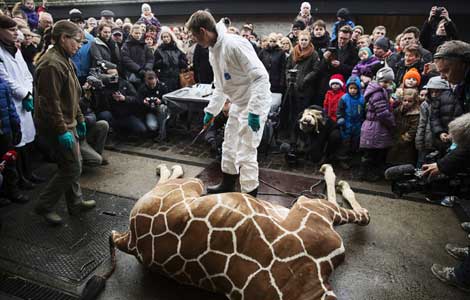
 Giraffe shot and dismembered in Copenhagen Zoo
Giraffe shot and dismembered in Copenhagen Zoo
Most Viewed
Editor's Picks

|

|

|

|
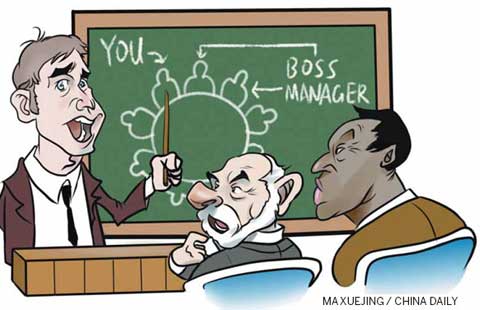
|
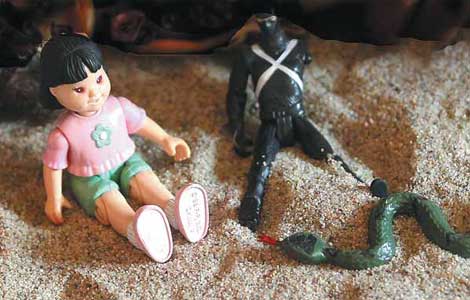
|
Today's Top News
Chinese consume too much food from animals
Obama to visit four Asian countries in April
Jade rabbit comes back to life
Embassy in talks over arrest
Beijing low on list of green cities
No casualties reported in Xinjiang quake
Abe's view on history rapped
Prostitution crackdown expands in Guangdong
US Weekly

|

|
